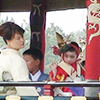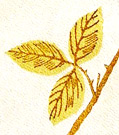Yone Noguchi (1875-1947)

Yonejiro Noguchi was born in 1875 in Tsushima, near Nagoya, the fourth son of a merchant Dembei Noguchi and his wife Kuwa.
While studying at Keio Gijuku, Yonejiro decided, with the encouragement of Keio founder Yukichi Fukuzawa, to travel to the United States.
Eleven Years Abroad
He arrived in San Francisco in 1893, and worked for a time for a Japanese-American newspaper and also as a "schoolboy" or domestic worker. In 1895, he called on a famous California poet named Joaquin Miller, who lived in the hills of nearby Oakland, and was delighted when Miller invited him to live in a cabin on his estate, now known as Joaquin Miller Park.
Noguchi's desire to become an English poet was encouraged by Miller, and in 1896, he was able to publish the first of his poems in a small San Francisco magazine called The Lark, a project of a group of bohemian writers known as Les Jeunes, led by Gelett Burgess. Noguchi was hailed as "The Latest Thing in Poets," but his fame led to a backlash as he was accused of plagiarizing from the poems of Edgar Allan Poe. The following year The Lark's editors, Gelett Burgess and Porter Garnett, and publisher William Doxey published Noguchi's first book of poetry, Seen and Unseen, Or, Memoirs of a Homeless Snail to generally favorable reviews from Willa Cather, among others. Later the same year, Doxey published Noguchi's second book of poems, The Voice of the Valley, a collection of poems about a trip to Yosemite. Noguchi's admirer, the travel writer Charles Warren Stoddard, contributed a preface to the book.
 During
the next few years, Noguchi divided his time between Oakland and San Francisco,
producing his own short-lived magazine called The Twilight and working
on a novel about a Japanese girl traveling in America. In 1900, he
traveled to the East Coast, where, with the help of
Léonie Gilmour, he completed
the novel, published by Frederick Stokes in 1902 as
The American Diary of a Japanese
Girl.
During
the next few years, Noguchi divided his time between Oakland and San Francisco,
producing his own short-lived magazine called The Twilight and working
on a novel about a Japanese girl traveling in America. In 1900, he
traveled to the East Coast, where, with the help of
Léonie Gilmour, he completed
the novel, published by Frederick Stokes in 1902 as
The American Diary of a Japanese
Girl.
At the end of 1902, Noguchi traveled to England. With the help of his Japanese artist friend, Yoshio Markino, he self-published a sixteen-page pamphlet of verse, From the Eastern Sea, was remarkably successful. Noguchi received support from a number of well-known writers, and was able to publish a longer edition of From the Eastern Sea with the Unicorn Press.
Returning to New York in 1903, Noguchi continued to encounter difficulties with American publishers, finding himself unable arrange American publication for From the Eastern Sea, or for The American Letters of a Japanese Parlor-Maid, the sequel to his first novel. After the onset of the Russo-Japanese War in 1904, however, he was able to publish numerous magazine and newspaper articles on subjects relating to Japan. Among his articles of this period, "A Proposal to American Poets" (1904), which marks the beginning of the English haiku movement, is probably the most important.
Return to Japan
Noguchi returned to Japan in the fall of 1904. His foreign success was much discussed among the Japanese literati upon his return. Noguchi accepted a position as Professor of English Literature at Keio University the following year.
In the Fall of 1903 Noguchi and Léonie Gilmour had briefly attempted a common-law marriage that ended in the early months of 1904. Gilmour's belief that she might be pregnant proved accurate, and she joined her mother in Los Angeles where she gave birth to a boy in November, an event reported in the Los Angeles Herald's story, "Yone Noguchi's Babe Pride of Hospital." Gilmour initially rebuffed Noguchi's proposal to join him in Japan, but finally did so in 1907. The attempt at reconciliation was not very successful, however, in part because Noguchi had in the interim become involved with a Japanese woman, Matsuko Takeda. For several years, however, he managed to juggle the two relationships with the help of a third residence at the Engakuji Zen temple in Kamakura.
In spite of his domestic complications, Noguchi was extremely prolific during this period. While the Russo-Japanese War continued, he contributed news articles and Japan-related features to American newspapers and magazines: "Sada Yacco" (New York Dramatic Mirror, 1906), "Marquis Oyama and His Wife" (National Magazine, 1907). In November 1906, he began writing a weekly English book review column for the Japan Times, which he continued until the beginning of 1908. Among his Japan Times contributions, his seminal 1907 essay "Mr. Yeats and the No" was perhaps the most notable, although many others, such as the "Through a Japanese Screen" column introducing Tanka revisionist Naobumi Ochiai, are also of interest. He also regularly contributed longer articles in English (and sometimes Japanese) to the bilingual Japanese magazine Taiyō (The Sun Trade Journal) on topics such as Onoto Watanna and her Japanese Work. And there were numerous translations, notably Ten Kiogen in English (1907) and the first English translation of the popular tanka anthology, Hyakunin Isshu.
During this period, Noguchi began to view himself as a Japanese Lafcadio Hearn, writing poetry, criticism, essays, and translations, in both English and Japanese. Although Hearn had died soon after Noguchi's return to Japan, Noguchi had attended his funeral and subsequently befriended Hearn's widow and a number of Hearn's former students, and arranged for Léonie to tutor Hearn's children. His interest in Hearn led to the eventual publication of Lafcadio Hearn in Japan in 1910.
Lectures in England and America
 In
1913, Noguchi was invited by poet-laureate Robert Bridges to lecture at
Oxford. The trip resulted in the publication of a number of books,
including Through the Torii,
The Story of Yone Noguchi, The Spirit of Japanese Poetry,
and The Spirit of Japanese Art.
In
1913, Noguchi was invited by poet-laureate Robert Bridges to lecture at
Oxford. The trip resulted in the publication of a number of books,
including Through the Torii,
The Story of Yone Noguchi, The Spirit of Japanese Poetry,
and The Spirit of Japanese Art.
In 1919 he returned to America for a transcontinental lecture tour, which led to the publication of Japanese Hokkus (1920), Japan and America (1921) and Selected Poems of Yone Noguchi (1921).
The Japanese Poet
Beginning in 1921, he began writing poetry mainly in Japanese, and a thirty-five volume set of collected Japanese writings was published between 1925 and 1928. His English book publications after 1921 were almost exclusively devoted to Japanese art. Although he wrote some of his best English essays during this period, such as the amusing essay, "Hobby," American and British publishers and editors were often unreceptive to his work. Although Noguchi continued to criticise Japan in essays like "Psychology of Modern Japan," his politics became increasingly nationalistic during the 1920s and 1930s.
A trip to India in 1935, described in his essays "Kinchinjanga" and "Indian Impressions," was the subject of his last volume of poems in English, The Ganges Calls Me (1938).
Noguchi became a staunch supporter of the Japanese role in the Pacific War, contributing a number of pro-war poems and songs to the war effort. When his Tokyo home was destroyed by Allied bombing in 1945, he took refuge in Toyooka-mura, where he spent the remaining two years of his life. He died there, of stomach cancer, on July 13, 1947.



















